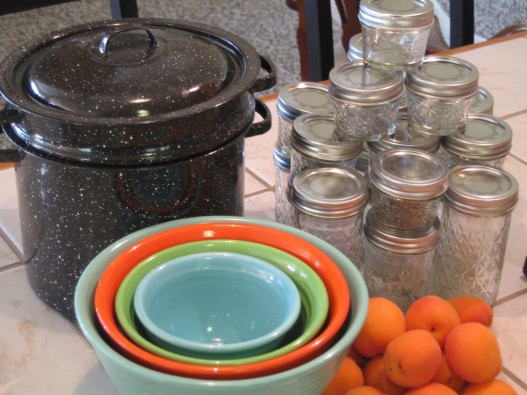 |
There is no need to go out a buy a bunch of new equipment for this process. What you have in your own kitchen will do fine. If you need to add a few utensils for your canning projects most neighborhood grocery stores carry all the necessary items.
What you will need:
Use any large pot you have at home.
Jar Funnel for easy pouring
Ladle for scooping hot liquids
Tongs to remove and arrange whole or chopped fruits and vegetables in Canning jars
Small stove top pan to sterilize the jar bands
Regular or wide mouth canning jars with lids and bands
Jar lifter to safely remove jars from the water-bath (I use a clean hand towel)
Tablespoon, to skim foam off hot liquid
Measuring cups
Measuring spoons
Kitchen timer
Cutting board
Sharp knife
Jar Preparation
Safe handling of all your utensils, jars and kitchen surfaces is a must when canning at home. These guidelines must be followed to make sure food safety. We wouldn't want our friends and family getting sick from eating food that we've prepared for them, so be vigilant with your jar preparation.
Select Jars and Cleaning
Make sure to check all your jars for any cracks or nicks in the surface. Discard jar if you see any signs of damage. Check lids and rims for dents or unevenness and discard any that are defective or damaged. I like to use an antibacterial spray on my counters surfaces and in the sink before canning. Fill your clean sink with hot soapy water and gently wash jars with a clean rag. Make sure not to use brushes with wire or previously used sponges. Rinse jars with hot water and place on a clean kitchen towel.
Heating
Jars must be heated for 10-15 minutes before filling to kill any remaining bacteria. Submerge the jars into pot with water about 3-5 inches deep (smaller jars can be stacked) and bring water to a boil. Right when the water begins to boil, reduce the heat and simmer until ready to use. If you have a kitchen thermometer check the temperature occasionally (180 degrees F). I just keep my jars at a low rumble so they stay extra hot and then I don’t have to stop to check the water while I’m in the middle of canning. Never pour hot liquids into a cold jar.
Lid and Band Preparation
Two piece vacuüm caps generally come with your boxed sets of jars.
Remove the lids and bands and check for any damage. Wash the lids and bands in hot soapy water (manufactures suggest never to reuse the lids or bands) place only the lids in hot water on the stove and simmer for 10-15 minutes. When the sealing compound is heated to 180 degrees F you will make a better seal.
Now you're ready to go…


Rebecka
Thanks Cali, I've love using bleach unfortunately, now that we live in the mountains I’ve had to adjust to septic and well water. Bleach is a really big no-no. I’ve had to find a safer method of disinfecting and with all the new environmentally safe products on the market, it’s been a breeze. On the upside, I have the sweetest tasting water from the natural spring that runs under our property. I really believe that the water we use to cook with, makes a big difference in the taste of the finished product. I couldn't stand the taste or smell of the water when I lived in Florida. It smelled like sulfur when you took a shower and with all the rotting mangroves, the smell of spoiled eggs was disgusting. I never really got used to it. I used filtered water for all my cooking but I could always taste the nasty sulfur.
Cali Cassels Hicks
Rebecka,I love the tip about the antibacterial spray. That should save me a lot of time in the future. I've been washing everything down with a bleach-based cleaner that requires rinsing. You're a genius!Thanks,Cali